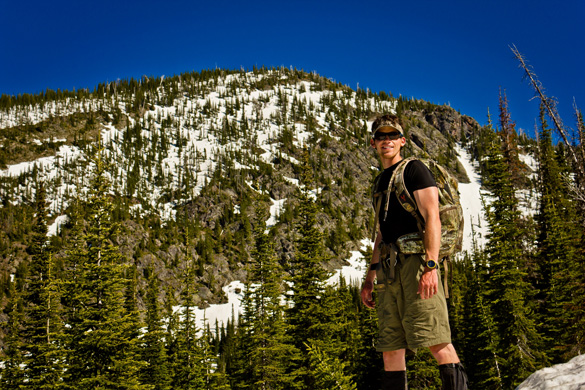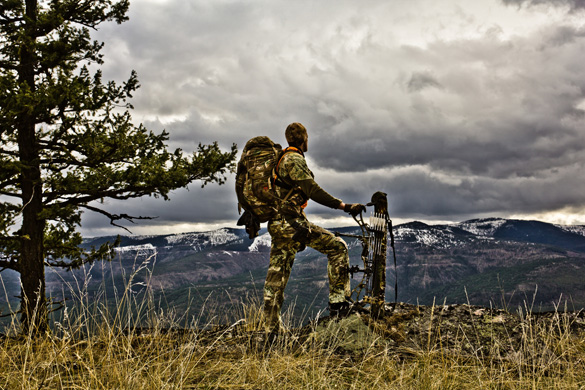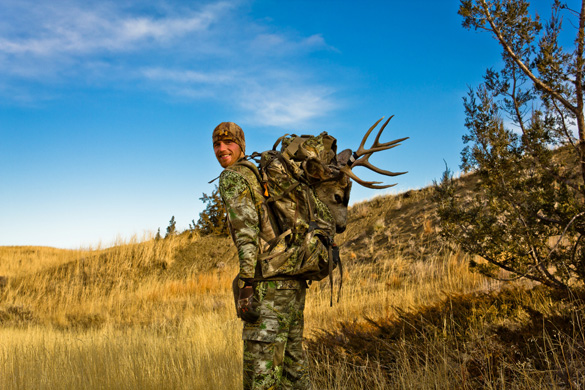LAST UPDATED: May 1st, 2015
Written by Bowhunting.com contributor Brady Miller.
Many factors come into play when you are choosing the right backpack for a hunt. Backpacks come in all shapes and sizes nowadays. It is very easy to get overwhelmed when it comes to finding the right pack for each hunting application. Hopefully after reading this you will have a little insight on ways you can go about choosing a backpack for an upcoming hunt.
From my experience, when it comes to packs, you really get what you pay for- I would always suggest avoiding going the cheap route on a backpack. You are setting yourself up for a world of hurt if you don’t take quality into consideration, especially if you are hunting the mountains for an extended period of time. Buying the best of everything really doesn’t fit into everyone’s budget, but you can prioritize your gear list to see if you can save money in other areas.
Your Target Animal
Finding the right pack is a critical element in how enjoyable it will be to carry the weight of all your gear during your hunt. Packs are made for a variety of purposes, and there is really no one pack for each type of hunt. So you need to ask yourself what type of hunting you will be using the pack for. Are you backpacking into the backcountry on a weeklong bivy type hunt? Are you hunting whitetails out of a treestand? Or are you spot and stalk hunting and returning to your vehicle each evening? For example, a backpack that you might use for whitetails will not cut it for multiple days in the mountains for elk as it really won’t have the proper suspension system to haul the required weight.
Your Body Type
When selecting a backpack you absolutely need it to fit comfortably. Make sure you go with a pack that fits your torso length and has the best suspension system. Nothing is more uncomfortable than wearing a pack that is designed for a shorter or longer body length. The overall fit of your backpack will make a world of difference between comfort while hunting or true excruciating back pain. Above all, if the pack doesn’t fit your body type properly, then it doesn’t matter how great the pack is designed, you will be uncomfortable.
Not only is a quality backpack essential for hunting, they are also great for post-season scouting which often leads to more filled tags.
A Place For Everything
When looking at packs, I place a high importance on the organization of gear through storage compartments. This enables you to quickly grab an item out of your pack, and over time, you will learn where each piece of your gear is. For example, when I am looking at a backpack for backcountry hunting, I like to have a specific pocket for handy access to such items as a tripod, spotting scope, water bladder, snacks, GPS, and a sleeping bag. It is also a huge benefit if the pack has waist belt pockets and straps for carrying the bow on the outside. Decide what you want to use the pack for and what features you need, and then start looking for something that falls into those categories.
Backcountry Hauling
In my opinion your backpack is one, if not the most, important piece of gear if you are hunting the backcountry for elk, mule deer, or any western animal. Before you buy your pack, you have to remember that it is easy for a pack to be comfortable at a lower weight. But how will it stand up when you are packing seven days worth of gear, camp, and food? Or how will it hold up when you place an elk quarter or a boned out mule deer in the pack? I always keep this in mind when I am trying on a pack. It is this reason that once I get a pack to my house, I will load it up with weight and go on a small backpacking trip to see how it handles.
You never really know where your hunt might take you, therefore, be sure to take the time to choose a backpack system that can handle a variety of hunting situations.
Size Matters
For weekend hunts you can get by with a 3,000 cubic inch pack if you are a minimalist, utilize the lightest weight gear, and are not afraid of giving up some comfort. For week long hunts I prefer a pack in the size range of 4,500 to 7,000 cubic inches. Having multiple size packs is great for a few reasons…you do not need the extra weight which can tire you out if you’re climbing mountains all day carrying a 7,000 cubic inch pack if you are only hunting for two days. The same goes for trying to use a 3,000 cubic inch pack for a week long hunt. Yes it is possible, but is that small pack capable of handling the weight? Also, to successfully fit all your gear items are going to be strapped to the outside of your pack which can lead to pack imbalance with weight being shifted in the wrong areas. Plus, if you decide to move camp each day following a herd of elk, getting all that gear organized and strapped on each morning is a real pain. Keep in mind though, if you use a small pack it will reduce the amount of “extra” gear you bring. You can forgo a little comfort on a backcountry hunt, as you really don’t need everything in your hunting bin to have a successful time in the mountains.
In addition, thought must be taken on how you plan on getting your animal out of the backcountry. Are you going to try to pack out your entire camp, plus part of your downed animal in the first trip? If so, you are going to need a pack capable of handling that much weight. If not, you might be able to get by with a lighter weight pack if you will just head back to a predetermined location and pick up a meat hauling pack.
Internal or External Frame
The trend in the last decade has been utilizing internal frame packs rather than external frame packs for backcountry style hunting. Each pack has its pro’s and con’s, and both designs will see their use in hunting situations for years to come.
External frame packs hold heavy weight very well and they also help with venting the sweat off your back due to the airflow between the frame’s padding and your back. They also are great for hauling meat off the mountain. The negative sides of externals are that they have a tendency to be a little unstable due to the weight being away from your back. Also they are usually blocky and heavier than an internal frame design.
An internal frame is considerably more comfortable than an external frame. Internal frame packs conform to your body instead of forcing your body to conform to the pack, which greatly helps with balance. With the numerous adjustments of an internal frame, you have the ability to distribute the weight to different muscle groups and give other muscles a rest. A disadvantage of an internal frame is that, since it fits close to the back, it tends to be hotter than external frames. I have used both styles of packs and I favor internal frame packs for my style of hunting.
The true measure of a pack is its ability to help you reach your bowhunting goals. If your current model doesn’t, or hinders your ability to do so, then it should be passed on for a better option within yor budget.
Whitetail Packs
For the whitetail hunter, a backpack is still an essential piece of gear. The perfect pack for the whitetail hunter is one that can carry all your hunting gear for a day hunt. Most of my whitetail hunting has been from a treestand, so I look for a pack that is lightweight and compact to hang next to my stand, which also has a lot of external pockets so I can keep some of my gear ready for when I need it. Sometimes being mobile in the woods is important, so I also ensure my pack can strap a treestand or blind on the outside for those just-in-case moments. I would also utilize the same lightweight pack on a day hunt for spot and stalk mule deer. Sometimes a hybrid type fanny pack can be a beneficial alternative to a backpack for treestand hunting; or for those spot and stalk situations when not much gear is needed. These hybrid fanny packs utilize shoulder straps, making them extremely comfortable for all day walking or for hiking to a stand.
Conclusion
Whether you’re an adventurous mountain hunter who plans on living off what you carry on your back for a week, a diehard whitetail hunter spending a day in the stand, or a spot and stalk enthusiast, having a quality backpack that fits your body and your specific needs is essential. It will not only aid in comfort, but will aid in your success by allowing you to hunt harder knowing that you have all the required gear handy.








